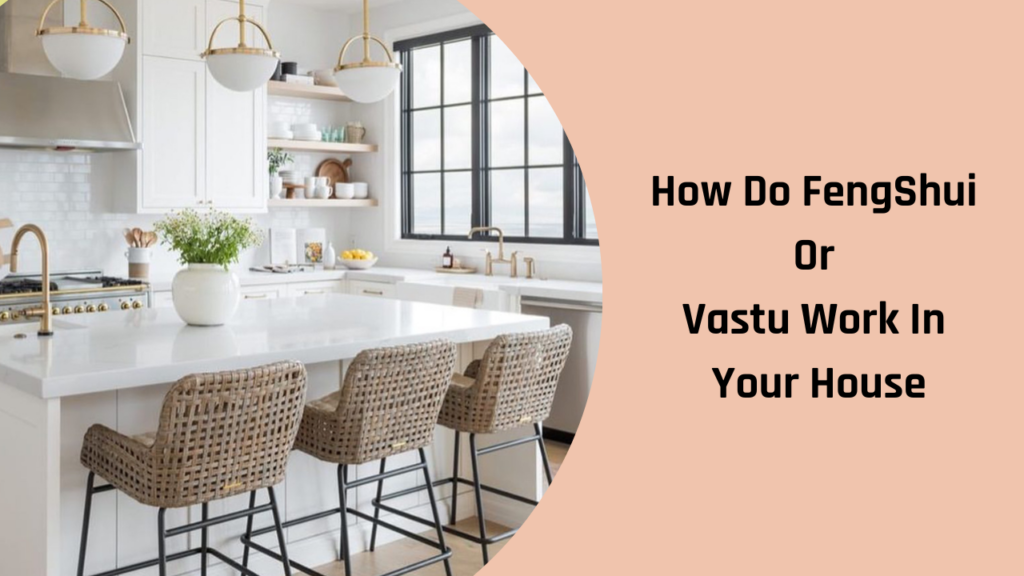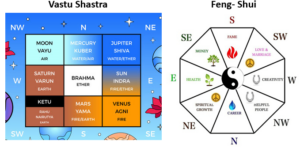How Do FengShui Or Vastu Work In Your House

All around us, many forces and energy are at work. Their influence has an impact on us in some way. Our attitude and wellbeing are influenced by everything around us, including furniture location, clothing, colours, and objects. One can feel happier, calmer, and more positive just by organising their belongings.
Also Read:- How Do FengShui Or Vastu Work In Your House
What is FengShui?
The Chinese characters “Feng,” which means wind, and “Shui,” which means water, can be used to break down the meaning of FengShui. The notion that human life is connected to and flows with its surroundings is derived from ancient poetry.
The discipline of arranging objects in living spaces to create harmony with the natural world is known as feng shui. FengShui in your home includes doing this. The goal is to channel energy forces and establish harmony between a person’s environment and themselves.
In Asian culture, this manner of thinking is referred to as the Tao, which means “the path” in English. All of the essential principles of FengShui are based on the idea that Taoism is the way of nature. In Asian culture, this manner of thinking is referred to as the Tao, which means “the path” in English. All of the essential principles of FengShui are based on the belief that Taoism is the philosophy of nature.

What is Vastu?
The entire purpose of Vastu Shastra is to create and draw in good cosmic energy. And because of this vitality, we are able to work harder and lead fuller lives. Vastu-compliant environments are said to promote health and happiness in residents and employees. The ancient Indian culture is responsible for the development of yoga, meditation, Ayurveda, and other healthy disciplines and practices. Another illustration of how wise our ancestors were is the Vastu Shastra. Every type of architecture has mirrored the relationships and perspectives of man. An individual can add more meaning to his creations by building in accordance with Vastu.
Apart from the elements, the Vastu Shastra’s directions are the most important part of this ancient tradition. People must be aware of this since it is crucial to make sure that everything is in its proper location while building a house. Here are some Vastu guidelines for each direction:
East
East is the direction of prosperity. All of the rooms that face east include the entryway, living room, study, and place of prayer. Treasure chests, lockers, and other storage spaces should face east to promote wealth. The east should not have a kitchen or bathroom. The west, southwest, and north-west directions should not be prioritised above the east direction.
West
In the west, a tank or a staircase are preferred above anything else. One could think about setting up an office here as a backup option, particularly inside the home. The western direction of the house is a good place to store trash cans or build a garage.
North
Keep northern buildings to a minimum to maintain optimal effectiveness. The north will surely become less prosperous if there are any permanent structures there. Having any open space in the northern hemisphere would be a sensible choice because research has shown that the UV radiation generated by the Sun has the least harmful effects there.
South
Keep the portion of the house facing the south high in relation to the other parts of the house so that it will cast a shadow on the other parts of the house. In the southern portion, keep a tank or an overhead tank full.
Is there any difference between FengShui and Vastu?
The subject of Vastu vs. FengShui is hotly contested. However, the majority of people commonly mix up the two to benefit from either. Despite having certain core concepts in common, Feng Shui and Vastu Shastra diverge greatly in some respects. FengShui contains far simpler principles that you can use at home at any time, while the notions of Vastu are better applied to a home that is being built from the ground up.
Vastu Shastra is based on science, whereas FengShui is based on geographical considerations. Vastu Shastra is more concerned with creating a suitable home in accordance with the principles of this philosophy whereas FengShui supports a pleasant way of life and enhances the flow of positive energy at home. The objects that the two theories use are in fact a key difference between them. While Vastu promotes the usage of Tulsi plants and aligning Ganesha sculptures, FengShui makes use of wind chimes, smiling Buddhas, and bamboos.
What Are The Similarities Between Fengshui And Vastu?
Both FengShui and Vastu Shastra are built on strong cosmic energy. The fact that both strategies are underpinned by mathematical computations is one of their most crucial features. Both of these methods hold that remedies can be provided by strategically placing objects and tools about the house to increase energies. Putting up statues of deities or lighting candles are two examples. Both tenets specifically forbid clutter in the home. According to both schools of thought, the home’s centre is where all of the energy converges, making it a crucial part of the structure. Both Vastu Shastra and Feng Shui use the eight compass directions to choose location and design choices as well as five elements to draw positive energy.
How do FengShui or Vastu work in your house?
Ancient science defined design, measurements, space organisation, and spatial geometry. By lining up geometric patterns, symmetry, and orientations, Vastu Shastra aims to optimise the advantages of nature’s beneficial energies.
There are five basic elements that make up the cosmos and everything in it. The elements consist of Earth, fire, wind, water, and space. All five elements, as well as spatial orientation, magnetic fields, and the gravitational pull of the Earth and the entire cosmos, are utilised by Vastu Shastra. This ancient scientific method accounts for most natural phenomena, including wind speed, sunlight, the impact of UV radiation, and rainfall intensity.
As we all know, the Sun is the primary heavenly body that transmits light and heat and is the cause of life on Earth; for this reason, the Sun is referred to in ancient Indian literature as the “Soul of the Universe.” Humans are able to utilise the Sun’s unbounded energy to the fullest extent thanks to the Vastu shastra principles.
Our planet’s home, the Earth, is like a mother to us and is a treasure trove of all comforts and happiness that one can never truly obtain elsewhere. Vastu shastra principles allow individuals to maximise the benefits of mother earth’s extensive effort.
In FengShui, furniture placement in a space is done in accordance with the natural energy flow. The placement of furniture is done to attract good “chi.” Maintaining order in the house is a great way to use FengShui. The basic guidelines listed below can be used by everyone to establish an atmosphere of peace, relaxation, and tranquilly:
- Keep your appearance tidy and organised.
- As much as possible, keep your bed away from the window.
- Recognize your colours
- Utilise the Bagua Map wisely.
- Keep leisure spaces away from work places.
Conclusion
Whether you practise Vastu or Feng Shui, you must comprehend the fundamental concepts behind the theories. Such laws or theories are not the only things that affect your wellbeing. It is what brings you joy and contentment. These are merely scientific hypotheses offered to facilitate your decision-making.








